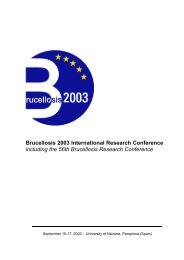Aportes filosóficos de Charles Sanders Peirce - Universidad de ...
Aportes filosóficos de Charles Sanders Peirce - Universidad de ...
Aportes filosóficos de Charles Sanders Peirce - Universidad de ...
You also want an ePaper? Increase the reach of your titles
YUMPU automatically turns print PDFs into web optimized ePapers that Google loves.
27<br />
Pasemos ahora al símbolo, el más problemático <strong>de</strong> los signos peirceanos. El<br />
símbolo es el único signo que nos permite acce<strong>de</strong>r a conceptos universales: “Los<br />
símbolos están particularmente lejos <strong>de</strong> la Verdad misma. Son abstraídos” 69 Como el<br />
signo simbólico no indica ni semeja lo que significa, es necesario un proceso <strong>de</strong><br />
interpretación más complejo para que sea efectivo. Todos los signos artificiales,<br />
aquellos que significan por convención, al menos en cuanto artificiales, son símbolos.<br />
Los símbolos son signos que representan sus objetos por convención o hábito. 70<br />
“Any ordinary word, as "give," "bird," "marriage," is an example of a<br />
symbol. It is applicable to whatever may be found to realize the i<strong>de</strong>a connected<br />
with the word; it does not, in itself, i<strong>de</strong>ntify those things. It does not show us a<br />
bird, nor enact before our eyes a giving or a marriage, but supposes that we are<br />
able to imagine those things, and have associated the word with them.” 71<br />
Ahora bien, esta clasificación no presenta dificulta<strong>de</strong>s <strong>de</strong> ningún tipo: sólo es<br />
<strong>de</strong>scriptiva. Pero <strong>Peirce</strong> relaciona esto con todo su bagaje filosófico, y entonces sí<br />
comienzan a surgir elaboraciones más complejas. Esto ocurre sobre todo en las<br />
subclasificaciones <strong>de</strong> estas tres clases <strong>de</strong> signos. Como ya vimos, la palabra es signo<br />
exterior <strong>de</strong> un signo interior. Ambos signos pue<strong>de</strong>n ser <strong>de</strong> clases distintas:<br />
“Now a common noun [such] as “man”, standing alone, is certainly an<br />
in<strong>de</strong>x, but not of the object it <strong>de</strong>notes. It is an in<strong>de</strong>x of the mental object which it<br />
calls up. It is the in<strong>de</strong>x of an icon; for it <strong>de</strong>notes whatever there may be which is<br />
like that image.” 72<br />
Los signos implican multiplicidad no sólo porque <strong>de</strong>ben implicar el signo formal<br />
o concepto para ser entendidos por el hombre, sino que en muchos casos son<br />
polisignos. Una frase, por ejemplo ‘hay que poner las barbas en remojo’, está<br />
compuesta por, al menos, dos términos. ‘Barbas’ y ‘remojo’ son dos signos. También<br />
69 New elements, EP2, pág. 307: “Symbols are particularly remote from the Truth itself.<br />
They are abstracted.”<br />
70 Cf. Nathan Houser y Christian Kloesel, Notes, en EP1, pág. 382.<br />
71 What is a sign?, EP2, pág. 9.
















